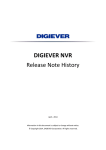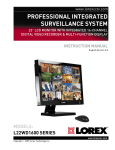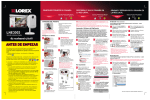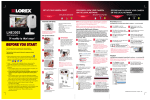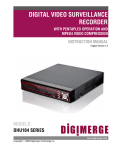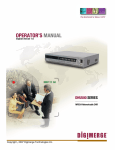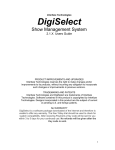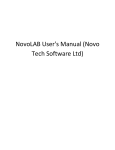Download Digimerge D2216 Series Instruction manual
Transcript
DIGICLIENT 8.0 Remote Agent Software MODEL: D2216 Series Instruction Manual English Version 1.0 Copyright © 2008 Digimerge Technologies Inc Table of Contents Table of Contents Software Installation .............................................................................. 4~5 DigiClient Software - Main Screen ........................................................ 6~9 Connection Manager ......................................................................... 10~13 Adding a Group ......................................................................................................................... 10 Adding a Site (Individual Unit Configuration) ............................................................................. 11 Configuration Tab ...................................................................................................................... 12 Modifying a Site ......................................................................................................................... 13 Remote Connection ................................................................................ 14 Search Functions .............................................................................. 15~17 Remote Setup ................................................................................... 18~25 Lorex Player ...................................................................................... 26~29 Video File Watermarking ........................................................................................................... 26 Archived Files ............................................................................................................................ 29 Web Client .............................................................................................. 30 Multiple Connection Setup - Appendix #1 ......................................... 31~32 Adding a Single Site with Multiple Systems ............................................................................... 31 Adding Multiple Sites with Multiple Systems ............................................................................. 32 Selecting a Site for Connection ................................................................................................. 32 Setting up Remote Viewing - Appendix #2 ....................................... 33~35 Network Setup / Remote Access Overview ............................................................................... 33 Network Checklist ...................................................................................................................... 34 About the DigiClient The DigiClient software package allows you to access your System from a remote location and perform the following functions. • View Live Video • Search & Playback previously recorded video from the remote System. • Remote setup of your System. • Record Video to your PC Hard Drive. • Archive & Backup Video to your PC • Playback data from Archive • Perform Firmware Upgrades over the Network Please visit us on the web for the most current Software Version, Manuals, Quick Start Guides and Firmware Upgrades. Additional Language Manuals are also available at http://www.digimerge.com 2 System Requirements System Requirements The DigiClient software (included with the System) has the following installation requirements. Minimum System Requirements: Operating System Windows 2000 Windows XP Home Edition Windows XP Professional Windows Vista Processor .Pentium 4 - 1.5 GHz Processor (or equivalent) Memory 256 MB RAM (512 Recommended) Hard Drive 50 MB - Installation space required * Additional Hard Drive space required for recording. Recorded file size will vary depending on recording quality settings Recommended System Requirements: Operating System Windows XP Home Edition Windows XP Professional Windows Vista Processor Pentium 4 / 3 GHz Processor (or equivalent) Memory 1024 MB RAM Hard Drive 50 MB - Installation space required * Additional Hard Drive space required for recording. Recorded file size will vary depending on recording quality settings Please refer to the DigiClient Software User Guide included with your System for further details. The DigiClient Software is now Microsoft Windows Vista™ compatible. Visit us on the web at www.digimerge.com for the most current software version and product updates. 3 Software Installation Software Installation Place the DigiClient Installation CD in the CD-ROM Drive of your Computer. The Software Install Wizard for the DigiClient Software will begin. 1. Click the NEXT button on both dialogue windows to continue the Installation: NOTE: If the Installation Process does not automatically start, you will have to begin the installation process manually: • Double Click the MY COMPUTER icon on your Desktop • Double Click the CD-ROM DRIVE (Drive Letter will vary depending on the number of drives in your computer) • Double Click the SETUP.EXE file (may appear as SETUP with no file extension, depending on your system settings. The Installation Process will begin. 4 Software Installation 2. Click the NEXT button on both dialogue windows to continue the Installation: NOTE: The following Program Shortcuts will be created: • Start Menu - Programs - DigiClient z DigiClient 8.0 z DigiPlayer 8.0 • Desktop Shortcuts for: z DigiClient z DigiPlayer 8.0 5 DigiClient Software - Main Screen DigiClient Software - Main Screen 4 1 5 6 7 8 9 10 11 12 2 13 3 14 1. Main Screen - Displays live Camera images (delays in images may be due to Network speed and connectivity strength). 2. Connection Status - Displays the System connection status. 3. Camera Selection Buttons - Displays the Connected Camera Number. Press buttons 1~8 to select a Camera Number for display. 4. Minimize / Exit • Minimizes the Client Window • Exit Program. 5. Time Display - Shows the current Time & Date. 6. Search / Setup Buttons • Search - Will Search for previously recorded video. • Local Setup - Configurations for Network Connection and Local Recording. • Remote Setup - Changes the setup on the remote System. 6 DigiClient Software - Main Screen 4 1 5 6 7 8 9 10 11 12 2 13 3 14 7. DVR Selection - Select the Connection ID for the System. 8. Connect / Disconnect Buttons • Connect: Connect to the remote System. • Disconnect: Disconnects from the remote System. 9. Screen Display - Changes the Screen View (Single, Quad, 9, 16, Full screen, Sequence or Manual). 10. Save to File - Saves the currently displayed video to an AVI file on the local PC. 11. Event viewer - Displays the Event List and Image Search functions. 12. PTZ Control Button - Controls Cameras with PTZ & Focus configured (refer to the Instruction Manual for the System). 13. Alarm and Audio Buttons • Mic. • Speaker Mute • Alarm On/Off. 14. Exit - Closes the DigiClient software. 7 DigiClient Software - Main Screen Screen View Controls Single Camera View 16 Camera View Quad View 8 Camera View Sequence Mode Full Screen View: Click to enlarge to Full Screen mode. Double click the screen to return to the regular view. Manual Switch Mode PTZ Controls Press the PTZ Button to access the extended PTZ Menu: P/T/Z Controller - Move the Camera Pan/Tilt using the Direction Keys FOCUS/ZOOM Select Button - Controls the Focus or Zoom Control using the + and - Buttons 8 DigiClient Software - Main Screen AVI File Conversion • Press the AVI (Video) Save Button to start Video Recording to the local PC • A dialogue box will appear while video is saving. Press STOP to end the video. • A second dialogue box will appear, indicating the saved files. The files are saved in the default location specified in the System Setup. Event Viewer • No - Event order number • DVR - Indicates the System name where the event originated. • CH - Indicates the channel where the event occurred (if applicable) • Time - Displays the Time and Date that the event occurred at. • Description - A description of the event type. 9 Connection Manager Connection Manager The Connection Manager contains the setup information to allow the user to remotely connect to the System. Adding a Group Group - Right click on ‘Site’ to add a New Group. A group can represent one or more Systems. For Example, you may have more than one system in your office, so would name your group ‘OFFICE’. Each individual unit can then be configured separately for connection. Enter a name for the Group. 10 Connection Manager Adding a Site (Individual Unit Configuration) DVR Information - Enter the information specific to the unit (refer to page 30 for setup instructions): • Name - Enter a name for the unit. • IP / Domain Name Enter the IP address or Domain Name for the System. This will vary depending on setup (Internal Network Connection or External Remote access through the Internet)- refer to page 30 for setup details. • Port - Set to 6100 by default. • User ID - Enter the USER ID to connect to the system (the USER ID is configured on the System - i.e. ADMIN - case sensitive). • Password - The password used to access the System (i.e. The ADMIN password is set to 1234 by default). Camera Assign - Set each camera to a portion of the 9-view window by using the drop down menu selections* ADD Button - Adds the site to the Group. OK Button - Accepts the changes and Closes the configuration Window * NOTE: The Camera Assignment may already be completed for the first 4 cameras - if you wish to change the defaults or add additional cameras, use the dropdown selection to change the configuration. 11 Connection Manager Configuration Tab Video OSD - Sets the display options for the Video: • Title - Displays the camera title • Name - Displays the name of the Camera • Date - Displays the date • Time - Displays the time • Resolution - Displays the video resolution Video Output - Sets the Video Output type to Overlay Mixer, Video Receiver or GDI. Video Mode - Sets the Video Mode: • Screen Switching Interval - Sets the screen switching time for Sequence view. • Alarm Popup - Sets the Display popup when an Alarm is detected on the system • Quality Improve Adjusts the Video quality 12 Save Directory - Browse to set the default location to save files on your PC for Video images. Password - Enter the System Password (1234 by default). Connection Manager Modifying a Site Left click on the selected Site (from the Group Listing) to access the settings. DVR Information - Can be changed if desired. Camera Assignments Camera default positions can be reassigned if desired. Event Selection - Selects the types of Events: • System • Alarm • Video • Record For detailed information on Events, refer to the System Instruction Manual. IN/OUT Selection - Sets the Audio and Alarm out. • Audio Out - Sends Audio to the System • Alarm Out - Sends Alarm to the System • Monitoring Audio - Sets the default channel for Audio Monitoring. • Connection Attempts Maximum number of connection retries. MODIFY Button - Saves changes to the Site configuration. DELETE Button Deletes the site from the Group Listing OK Button - Accepts the changes and Closes the configuration Window 13 Remote Connection Remote Connection Once the site setup profile has been created, a connection can then be made to the System: 1. Select the Site profile from the Dropdown List. 2. Press the CONNECT button. The Connection Status window displays the state of the connection. Once a successful connection to the System has been made, the black screen view will switch to Live Camera View mode. Once a connection is made, the cameras will appear onscreen in Quad view mode. NOTE: If another user is connected to the System using the same credentials (i.e ADMIN), the connection will be rejected. 14 Search Functions Search Functions The Remote Observation Setup allows the user to search for video and events. 1 3 4 5 6 7 2 8 1. Search Screen - Displays the Selected Video. 2. Search Bar - Search & Display Camera Recording Times (24 hours). 3. LIVE Button - Return to Live Viewing Mode SETUP Button - Access system settings. 4. Screen Layout - Change the display screen view. 5. SEARCH - Backup Video or Search for Events. 6. Camera Selection Button - Select individual cameras. 7. Quick Search - Find information by Date & Time. 8. Search Controller - Video playback controls 15 Search Functions Event Viewer Indicates 0~24 hour Time Indicates Recording Status: Grey (No Recording) and Blue (Recorded Data). Search Bar - Drag to select the recording time. Displays the Camera recording channel Volume Mute Channel Bar - Scroll to select different cameras. Search By Time Select date and Time Video Playback Controls: Play video in normal speed (Play and Reverse Playback) 16 Change Playback Speed (up to 64x Forward and Reverse) Search Functions Search Options Archive Copies a backup of the video data from the System to the local PC. • Time Range - Set the start and end times for backup. • Channel - Select channels to Backup. • Include Audio - Includes Audio with the video backup. Press OK to start the backup. A status window will appear for the backup process. Once complete, the window will disappear and the data will be saved in the designated folder. 17 Remote Setup Remote Setup The Remote Setup allows the user to make changes to the system from a remote location. Entering the System Password Checking Authority - To change the Remote System Settings, the user is required to re-enter the ADMIN password, and press OK. Recording Setup - Simple • Record Mode - Select the Recording Setup type (Simple or Advanced configuration). • Camera Group - Select Cameras 1~4 or 5~8 for setup. • Record Quality - Sets the Recording Quality. Select HIGHEST, HIGH, STANDARD or LOW. • Record Size - Sets the Recording Size (video display). Select 352x240, 704x240 or 704x480. • Record Frame Number - Sets the Recording Frame Rate. Select 1, 2, 3, 7 or 15 FPS • Use the Mouse to select or deselect Schedule options (Blue Highlighted blocks indicate that the segment is Selected). 18 Remote Setup Recording Setup - Advanced Select the Advanced option from the Record Mode dropdown menu. An window will appear to indicate that the Mode has changed. • Camera Group - Select the Channel Area (CH1~4 or CH5~8) • Schedule Mode - Set to Weekly or Daily. When the System is set to weekly mode, set each day individually • Pre Event Recording Time - Sets the Pre-Event Recording Time (between 0 ~ 5 Seconds). The Pre-Event records the data that occurred before the Event occurred. Refer to the System Instruction Manual for more details. • Post Event Recording Time - Sets the Post-Event Recording Time (between 5 ~ 180 Seconds). The Post-Event records the data that occurred after the Event occurred. Refer to the System Instruction Manual for more details • Alarm / Continuous / Motion Record Setup - Click the “Set” Button to setup the Cameras for Alarm, Continuous and Motion Recording: Set the Size, Recording Rate. Quality and Audio for each camera. Press OK to save the Settings. • Alarm / Continuous / Motion Recording Schedule - Use the mouse to select individual time blocks for Alarm, Continuous and Motion Recording. Selected blocks are displayed in Blue. 19 Remote Setup Camera Setup Settings for Individual Camera recording • Camera Group - Select Cameras 1~4 or 5~8 for setup. • Covert / Title - Sets the Covert status and Name for each camera. Refer to the System Instruction Manual for more details on the Covert Camera Setting. • Color Setup - Sets the Brightness, Contrast, Tint and Color for each camera. • PTZ Setup - Set the Address, PTZ Protocol and Baud rate for each camera. Click the Properties button to enter additional setup information. Refer to the specific PTZ Camera Manual for details on configuration. • Motion Area - Click the “Camera” Button to access the Motion Setup Menu. Select an area by click and dragging with the mouse. The Selection menu will automatically appear to Select/Deselect/Cancel the Motion Setup. An area selected will have Yellow Squares, and a deselected area will have white squares. 20 Remote Setup Sound Setup • Live Audio - Sets Live Audio to ON/ OFF. • Audio monitoring channel - Sets the channel for Live Audio Monitoring (1~4 Only). • Network Audio TX - Sets the Network Audio transmission to ON/ OFF. • Network Audio RX - Sets the Network Audio Receive to ON/OFF. • Buzzer Setup - Turns the alarm buzzer OFF when a button is pressed on the System Front Panel Keypad. 21 Remote Setup Event/Sensor Setup • Alarm Input - Sets the Alarm Input Operation to Enabled or Disabled, and sets the Type to Normally Open or Normally Closed. Refer to the System Manual for details on configuration of External Alarm devices. • HDD Event - Turns the Alarm On/Off when a problem is detected with the System Hard Drive. • Alarm Out - Sets the Alarm out for a secondary Alarm Device. Refer to the System Manual for details on configuration of External Alarm devices. • Operation: Set the Relay Connect with Alarm Sensor to ON/OFF. • Mode: Set the Reacted Relay to Latched or Transparent Mode. • Type: Set to Low (Normally Closed) or High (Normally Open) • Duration: Setup Reacted Relay Time. (5sec~5min or Until key-in) • HDD Event: Alarm On/Off when HDD has the problem. • Buzzer Out - Sets the audible buzzer alert when an event is detected. • Buzzer: On/Off • Duration: Sets the Buzzer time (5sec~5min or Until key-in). • Mode: Setup Reacted Relay as Latched/Transparent Mode. • HDD Event: Alarm On/Off when HDD has the problem. • E-mail Notification - Generates an email notification when an Event is detected. Refer to the System Manual for details on configuration of Email Notification. • HDD Event: Sends an email when a problem with the System drive is detected. • Notification: Turn the email send ON or OFF. • Frequency: Set the amount of time to wait until resending an email. 22 Remote Setup System Setup System Info - Displays the System Information including the Software and Hardware versions, Video Signal type, IP and MAC addresses, and Disk Space usage. • FW Upgrade: Select the FW Upgrade button to remotely upgrade the System firmware. Navigate to the location of the saved *.img Firmware File (download the most recent firmware from http://www.digimerge.com). Follow the prompts to install the Firmware on the Remote System. Once the remote system firmware has been upgraded, the system will reboot, and you will need to reconnect with the Remote Client Software. SMTP - Setup the mail server and user’s E-mail (sends an email notification via email when an event occurs): • Default Mail Server: If the box is checked, you have selected to use the Digimerge Mail Server. YOU WILL BE REQUIRED to set up your system on the Digimerge web based DDNS at http://ddns.digimerge.net to use the default mail server. Uncheck to use your own mail settings. 23 Remote Setup SMTP SECTION - Setup the mail server and user’s E-mail (for email send on Event notification): • Server: Your email settings (from your Internet Provider) for sending Email (if not using the Digimerge Mail server). • Port: Default port 25 • User: Enter the User ID used by the Internet Provider for Internet connectivity. • Password: Enter the Password used by the Internet Provider for Internet connectivity. • Security: Set the security to ON or OFF. • FTP: Contains the settings for the FTP Backup. Users - Setup/Modify System Users by pressing the “Add” or “Modify” buttons. • Network Speed - Set the network connection speed. • Disk Overwrite - Sets the System HDD Overwrite On/Off. • Record Time Limit - Select the time (Off, 12 hours, 1day, 2day, 3day, 1weeks or 1month). This option is only available if disk overwrite is set to ON. 24 Remote Setup Display Setup (Screensaver) • Auto Brightness - select the time (10 min., 20min, 30min, 40min, 50min or 1 hour). If a time is set, the Remote System screen will go dark after the set time interval. • Screensaver* - Turns the Screen Saver to On or OFF. The screensaver will blank the screen during the specified times if set to ON: • From: Turns the Screensaver ON (start time). • To: Turns the Screensaver OFF (end time). * If selecting the OFF setting, “the screen saver (Main Display Off) will be disabled. 25 DigiPlayer 8.0 DigiPlayer 8.0 The Backup Player will playback data previously saved to the PC Hard Drive, or files backed up from the system to a USB Memory Stick, Optical Drive (CD-RW / DVD-RW) or to FTP. The Backup Player can be launched from either the Start Menu or Desktop Shortcut To open a file, select the FOLDER ICON in the lower left of the screen. Navigate to the save location, and select the video file for playback. Video File Watermarking The archived video files have a file protection (referred to as Watermarking). When the Player loads a file, it checks the file to confirm that no editing or changes have been made. If changes are detected, a warning message is displayed indicating that the file has been altered. When the file is loaded, a prompt appears to allow the program to check the Watermark in the file. Choose YES to check the file, or NO to skip the watermark checking. To cancel the Watermark check, click the STOP button. Once the file has been checked, the Player will load the file for playback. 26 DigiPlayer 8.0 Video Playback Image (only one camera can be displayed at a time) Playback Controls (See previous Search options for details). Select the Date and Time for the video playback Displays the currently displayed file name and Total playback time for the video recording. Image Save Function • Click the ‘Save Image’ Icon during Video Playback. • Enter a file name, select a File Type (JPG or BMP), and Location. Press the SAVE Button. • The current image will be saved. Print Function • Prints the currently displayed image. Select the Printer, and press OK. 27 DigiPlayer 8.0 Log Viewer Search Button Press to perform a search based on Criteria Search Range Set the Start Date and TIme, and End Date and Time. Logs Displays logs (based on Search Range and Search Conditions). Displays the Log Number, Channel, Date and Description. Search Condition Select the Search criteria (Alarm, Motion, Continuous or System). OK Button Move to Previous or Next Page, or use the dropdown to select a specific page number. Event Viewer Displays a list of all Events. • NO - Event Number • DVR - Displays the System where the event originated from. • CH - Displays the channel number where the event occurred (if applicable. Some event types will not be display a Channel number) • Date and Time - The date and time that the event occurred • Description - Displays a description of the Event type. 28 Return to Timeline View (Search Mode). DigiPlayer 8.0 Archived Files Data can be archived in several ways: • Directly from the system using a Memory Stick or Removable Media (CD-RW / DVD-RW). • From the System to a remote location via FTP. • Using the DigiClient software application. Once the data has been archived, a directory will be created containing the following: • AVI Files: An AVI Format video file will be created for each channel selected for backup. The file name will include the information about the file including Backup Type, Channel Number, Date (Month, Day, Year) and Time (Hour, Minute, Second). In the example shown below, the file named: “FTP_ch01_0220081357_022008135 9_00.avi” indicates that the file was archived using FTP, for Channel 1, on the 22nd of March, 2008 at 1:59pm. • SETUP.EXE File: The Setup.exe file contains the codecs needed to playback the AVI video file. If the archived data is to be played back on a PC that does not have the DigiClient software or DigiPlayer software installed, the Setup.exe file included in the archive can be run to install the Codecs. Once the Codecs are installed, the video data can be played back on another player program (i.e. Windows Media Player, WinAmp, etc.). • TXT Log File: The txt log file is written to the folder, and includes details about the backup process. Data included in the backup log consists of: z Information about the System (Firmware version, backup archiving type) z Backup Requested Data (Selected Start and End times, channels for video and audio backup) z Backup Results (A log of each file created during the backup process including start and end time, and file size). z File Total (Displays the total number of files that were created in the backup archive directory). 29 Web Client Web Client Once the System is configured, a connection can be made using Internet Explorer (this is the only supported Web Browser). • Enter the IP Address or DDNS Address of the System in the Address Bar of Internet Explorer. • A prompt will appear for Active-X - choose to install the controls. • The DigiClient software will install remotely, and have the same functionality as the full installation (from CD). NOTE: Many factors impact the performance of your web browser such as security settings, popup blockers, firewall settings, routers, and other network conditions that are specific to the end user. Digimerge recommends using the included DigiClient software. 30 Multiple Connection Setup - Appendix #1 Multiple Connection Setup - Appendix #1 The “Site” can be used to connect to several remote systems at the same time (up to 16 systems). These systems can be at the same location, or can be at Multiple locations. Some examples include: • Adding multiple systems at the same location. For example, you may have an office that has more than one system at the location - use the client to connect to the system located at the Front Desk and the system located in the Warehouse at the same time. • Adding multiple systems at different locations. As an example, you may have several retail stores that are physically located in different areas of they city - use the client to set up a connection for each store using the stores’ specific DDNS or External IP address information to connect. Adding a Single Site with Multiple Systems To Configure Multiple Systems at one “Site”, add a site as shown on the previous page. You can add up to 4 systems to the site by: 1. Enter the information in the “DVR INFORMATION” section 2. Adding cameras to the drop down DVR Menu NOTE: You cannot overlap the camera locations. For example, if you assigned the first System to have cameras 1~4 appear in the top row, you cannot assign cameras 1~4 from the second system to the top row - use the second row down instead. 3. Click the ‘ADD’ button at the bottom to add the site. 4. Click on the Site Name to add another System to that location. 1 4 2 3 31 Multiple Connection Setup - Appendix #1 Adding Multiple Sites with Multiple Systems You can add Multiple Sites with Multiple Systems to the DigiClient, however you can only connect to one “Site” at a time. To add Multiple Sites with Multiple Systems: 1. Add a Site by right clicking on the ‘Site’ link on the right side menu. 2. Add a System to the site by entering the System Information, including z z z z Entering a Name Entering a Domain Entering the Port, User ID and Password Adding Cameras to the DVR Dropdown and clicking on the ADD button. Repeat to add more Systems to the selected site, by clicking on the Site Name and completing the fields. 3. Add a second site by right clicking on the ‘Site’ link on the right side menu, and repeat the steps. Selecting a Site for Connection To select a site, click on the drop down menu on the right side of the client. Select a Site from the list, and the connection window will appear. The Connection Status window displays all Systems configured for the site, and will attempt to connect to each site separately. Once the connections have been made, the systems will be displayed in the Split screen view. NOTE: To connect to a new site, you must first disconnect from the existing site. 32 Setting up Remote Viewing - Appendix #2 Setting up Remote Viewing - Appendix #2 Setting up the Remote Viewing Feature requires several steps. Networking skills are required to correctly configure the remote viewing functions. Please refer to the Hardware Manual included with your System for specific steps. What do you need? • The LCD/DVR System. • A PC with the installed with the DigiClient 8.0 software (refer to this Software Guide for installation instructions) • A Router (not provided with the system) and High Speed Cable or DSL Internet Connectivity (for remote viewing outside your network) Network Setup / Remote Access Overview The System can be remotely controlled using your existing network and the DigiClient 8.0 software or Internet Explorer. 1. Connect the System to the Router using the supplied Ethernet Cable. Power the System on. The System must be connected to the router prior to powering on the system. This allows the system to communicate on your network SYSTEM INTERNET ROUTER (Not Included) PC (Not Included) 2. Find the IP address of your System through the Menu System on the unit. 3. Enable PORT FORWARDING on your Router. Refer to the included Router Guide and Basics of Remote Video Access Guide for further assistance with your specific network setup and hardware. 4. Set up a web account at http://ddns.digimerge.net. 5. Setup the System DDNS. 6. Configure the software, using the information gathered on the following pages. 33 Setting up Remote Viewing - Appendix #2 Network Checklist The following checklist is provided to assist you in confirming that all steps have been successfully performed during Network Setup. Use this checklist in conjunction with the steps outlined on the following pages. NOTE: The following information can be found in the Hardware Manual included with the System. 1. I have the following: • High Speed Internet • A Router • The Ethernet Cable provided with this system • The System • A PC with the Remote Access software installed 2. I have confirmed that my System is set to automatically complete my Network settings (DHCP is set to ON): • Press the SETUP button on the Front Panel -or- Press SETUP on the Remote -or- Right Click on the screen and select the SETUP option. • Select the System Setup option • Select the System option • Select the Network Menu. Confirm that the options for both DHCP and DDNS have checkmarks in the boxes. 3. I have turned off the System, and performed the following: • Connected the Ethernet Cable to the back of the System • Connected the other end of the Ethernet Cable to my Router NOTE: Network Setup will not work if you do not have a router 4. I have found my System Information by either Pressing the ENTER button on the Front Panel -or- Pressing the INFO button on the Remote Control: • My IP Address is: ________________________________ • My MAC Address is: ______________________________ NOTE: If your IP address is showing as 127.0.0.1, please return to Step 1 and review all menu settings. Check to make sure that your Ethernet cable is properly connected to your Router and System. 34 Setting up Remote Viewing - Appendix #2 5. I have enabled PORT FORWARDING on my Router for: • Port 80 • Port 6100 NOTE: Each Router is different, therefore the port forwarding settings will vary by model. Please visit us on the web at http://www.digimerge.com for assistance with several of the most common router types. If your router is not listed, please refer to the manual that came with your Router, or your Router manufacturer for assistance. 6. I have configured the DDNS for remote access to my system at http://ddns.digimerge.net and my configuration information is: • Username: _______________________________ • Password: _______________________________ • Domain Name: ____________________________ 7. I have configured my System to connect to the DDNS Server by completing my Network settings: • Press the SETUP button on the Front Panel -or- Press SETUP on the Remote -or- Right Click on the screen and select the SETUP option. • Select the System Setup option • Select the System option • Select the Network Menu. • Select the DDNS Server option, and use your information to complete the DDNS Configuration: z z z z DDNS Server Name: DIGIMERGE (default) Domain Name: Enter the name you set for the DDNS web configuration. User ID: Enter your user ID Password: Enter your password • Click the DDNS Status button to confirm the connection details. • A success message will appear, and the system will restart. 8. Configure the Remote Access Software: • If you are connecting from within your network (i.e. The System and your PC are both inside your house), you only need to enter the IP address of the System into the software (i.e. 192.168.0.105) • If you are connecting from outside your network (i.e. The System is at Home, and your PC is at work), use the DDNS Domain Name to configure the software). 35 It’s all on the web Product Information Specification Sheets User Manuals Software Upgrades Quick Start Guides Firmware Upgrades VISIT www.digimerge.com www.digimerge.com Digimerge Technologies Inc.






































